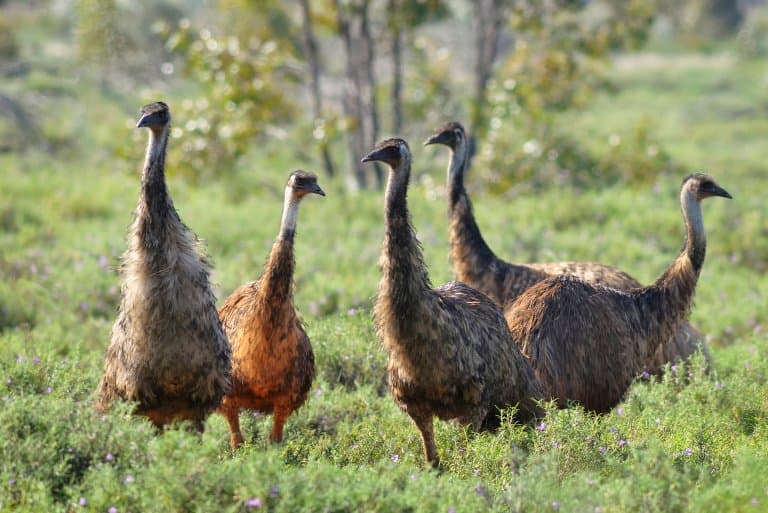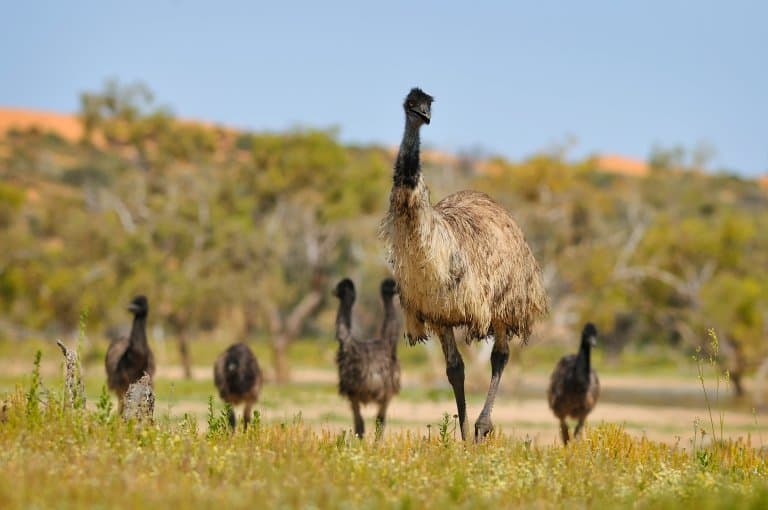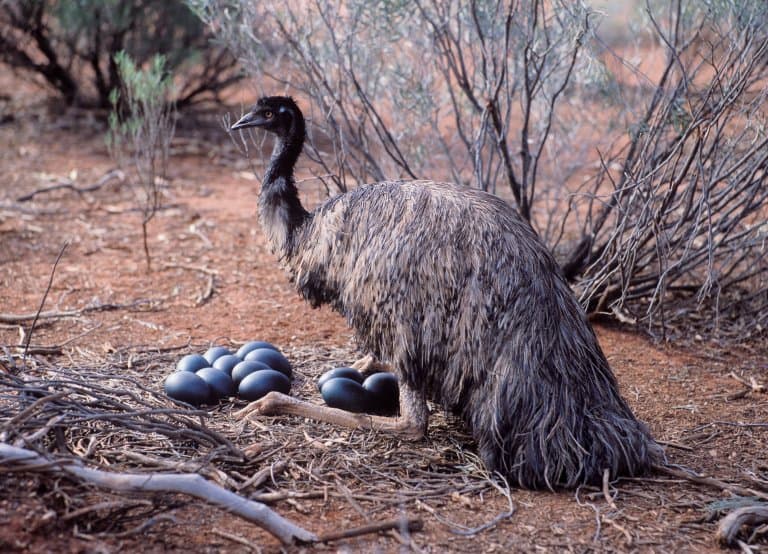Emu Profile
At least in Britain, the closest most people ever got to an emu was a mischievous toy bird with a man’s hand up it. But there’s so much more to these animals than is commonly known.
As a member of the ratites, they’re part of an ancient lineage that once included elephant birds like the 630kg Vorombe titan. The emu is a large flightless bird species that is native to Australia, and is the only living member left of its genus.

Emu Facts Overview
| Habitat: | Forest, heath and woodland, desert and plains |
| Location: | Australia |
| Lifespan: | 10+ years in captivity |
| Size: | Around 2m tall |
| Weight: | 50 to 55 kilograms (110 to 121lb) |
| Colour: | Grey-black |
| Diet: | Seeds, fruits, flowers and shoots |
| Predators: | Humans |
| Top Speed: | 31mph (50km/h) |
| No. of Species: | 1 |
| Conservation Status: | Least concern |
Emus are part of a diverse order ranging from the humble kiwi to the largest birds that ever roamed the earth. They’re one of the many ratites that evolved to be enormous, and they handle it well.
They inhabit savannah and woodlands across Australia, near to the coast and inland. They often travel in pairs, but can occassionally group in larger numbers known as a ‘mob’.
They spend the day foraging and will eat insects such as beetles, crickets and grasshoppers, as well as plants and grasses.
Domestic emus are playful, mischievous birds that have a specific kind of excited wiggle that they do when they’re enjoying themselves.
They also make the best noise of any animal on two legs. Thankfully, these quirky little weirdos are doing quite well, though climate change does seem to be making their lives more difficult.
Interesting Emu Facts
1. They’re a giant kiwi
The Kiwi of New Zealand (not the fruit) is a strange and charming little flightless bird that doesn’t appear to have an ounce of intimidation in it.
But appearances can be deceptive, and to those familiar with it, the kiwi is known as a feisty and aggressive little thing capable of fighting off a possum and possibly giving you a nasty nip.
So, armed with this knowledge, it might not be as surprising that a kiwi’s closest relative is the emu, a much more powerful and heavy animal, in a closely related family.
But the kiwi isn’t their closest relative, perhaps less surprisingly, the emu shares an order with cassowaries, those notoriously dinosaur-like ratites. Ostriches, on the other hand, are far more distantly related to emus, despite being closest in size.

2. They’re not as aggressive
A large bird like this is capable of intimidating and even injuring an adult human, but these events are rare and usually superficial.
Unlike the ostrich and the kiwi, emus aren’t particularly keen on attacking things, and will generally leave you alone. 1
3. They likely evolved from flying ancestors
It was thought that the ratites may have evolved from a common ancestor on the incredible supercontinent Gondwana, and diverged as various continental plates separated over the aeons. Another more likely hypothesis is that their ancestors flew to their respective islands and then lost their ability to fly when they discovered there were no predators to escape.
Ostriches appear to have branched first, rheas next, and then emus and cassowaries split from kiwis.
After the extinction of the dinosaurs, most of these lineages evolved gigantism over ten million years to fill the available ecological niches before mammals got in there and took them all. 2
4. They are the second-tallest bird left on earth
Emus are very tall, and the second-tallest bird left on earth, after the ostrich.
This is big, but in classic African faunal fashion, the ostrich is significantly bigger, at around a meter taller than the 2m emu.
They are the 5th heaviest bird in the world weighing up to 60kg, behind the two species of ostrich and cassowaries.

5. They can run up to 50 kph (31 mph)
As long-legged, flightless birds, you’d expect emus to be fast. These are accomplished walkers and runners and cover vast distances bipedally.
Emus are said to be able to run at 50km/h and walk long distances during migrations to new feeding zones.
These migrations tell researchers where food is low, and can be a way of monitoring the changing climate’s effect on the ecosystem.
Interestingly, while they are flightless, they do still have vestigial wings which they flap when running, perhaps to give them extra power or stabilisation at speed. At full gallop their strides can be as long as 9ft! 3
6. They dance
Their stumpy little feathered wings and huge shaggy coats make them look a lot like a sock puppet that’s just discovered legs, but despite the spectacle of it, the emu loves to dance as though nobody is watching.
During mating rituals, the incredible shaggy coat gets even more ruffled, and the male takes a curious position. 4
7. Emu have razor-sharp claws on its toes
Their feet have only three toes, each with sharp claws which are used as defensive weapons when needed like the cassowary.
The toes and claws are sizeable and can reach up to 6 inches in length.
They are used when in combat with opponents by kicking!

8. Small stones are swallowed to assist digestion
Emus will swallow stones to assist in grinding up food such as plant material in their gizzards.
The have also been reported to swallow various other random objects, such as shards of glass, car keys, jewellery and even charcoal.
9. They drum like a dinosaur
This is one of the eeriest sounds in the animal kingdom and is more fitting in a scene from the Cretaceous than anything you’d expect from a modern animal.
Fowl are relatively known for the guttural drumming noises, but a full-grown female emu has even a large turkey beat when it comes to banging the cans.
This remarkable sound emanates from the chest of the bird but is finished with a harmonious resonant vocalisation that gives it an uncanny and prehistoric presence. And the males seem to dig that. 5
10. Males build the nest
Sexy chest banging works pretty well for the fertile females, who will not have to do the work of either building the nest or looking after the eggs.
Males do both, and in exchange, he has access to multiple hens, who, between them, will compile a clutch of up to 25 emu eggs that the male will then incubate.
This is a 24/7 job, and the male takes it very seriously. No eating, drinking, or pooping will go on for the entirety of the two months that he’s on the eggs.
Males will then aggressively defend the youngsters on hatching, even from the females that stuck around as security during incubation.

11. This is a social time for them
The chicks will stay under the father’s care for another seven months, and this is the largest grouping of emus that typically occurs before the groups are split up.
During this time, while he will defend the young birds, the male is also tolerant of other lost chicks joining his flock.
12. They’re veterans
All of this power drumming and loyalty tactics set a good scene for an epic emu battle, and in 1932, the Great Emu War was the setting of just that.
In classic human fashion, the colonists set up shop uninvited among the native habitats and then got upset by the natives being there.
A bunch of ex-soldiers were sent to help farmers rid their land of the emu pests, but were more or less outsmarted by the birds, who for the most part avoided the bullets and ambush strategies employed by the soldiers.
Several emus were killed, and at the peak of the war, the casualties ammased at a rate of 100 birds per week. This topped out at 986 dead emus, at a rate of ten bullets used per bird.
The ineffectiveness of this mass extermination attempt led to future requests being denied by the government, though a bounty system in place proved to be much more effective, claiming the lives of over 50,000 more emus. Still, the species thrived.
Later, some very bright people had the tremendous idea of putting up a fence, which seemed to do the trick. 6
Emu Fact-File Summary
Scientific Classification
| Kingdom: | Animalia |
| Phylum: | Chordata |
| Class: | Aves |
| Order: | Casuariiformes |
| Family: | Casuariidae |
| Genus: | Dromaius |
| Species: | Dromaius Novaehollandiae |
Fact Sources & References
- Moyer Movies (2008), “When Emus Attack – Emu Chases Man”, YouTube.
- Nell Greenfieldboyce (2014), “Big Flightless Birds Come From High-Flying Ancestors”, NPR.
- Jon Daly (2021), “Emu migration underway across outback, after replenishing rains in NSW”, News.
- Eddie Stose (2007), “Emus Dancing”, Youtube.
- “Emu Behaviour”, Emu Services.
- URVIJA BANERJI (2016), “In 1932, Australia Started an ‘Emu War’—And Lost”, Atlas Obscura.
